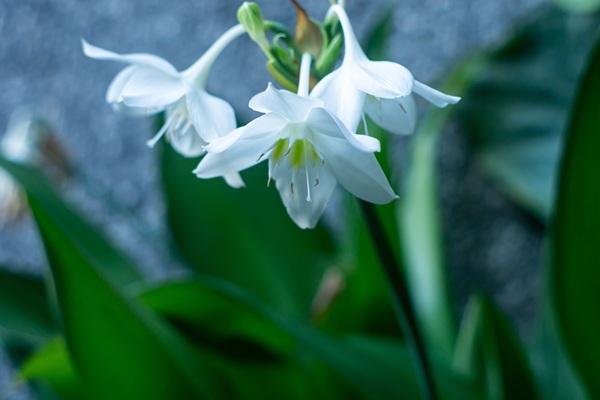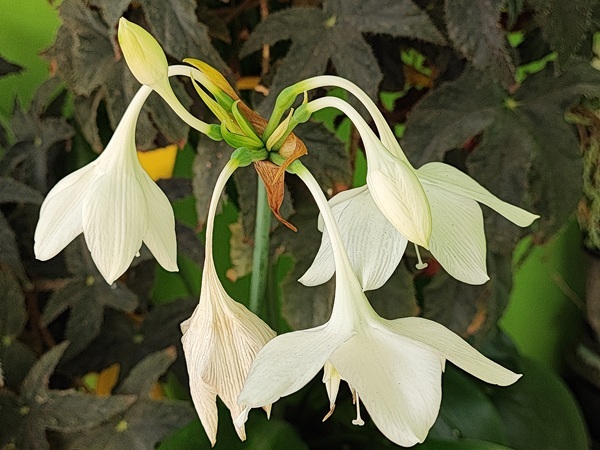

Blooms and Foliage: Each pure white flower has a lovely, pleasant sweet fragrance and will be 3-4 inches across. Each bloom is star-shaped with a prominent central cup (like a daffoidl) but with a more elegant, tropical look. There will typically be 3-6 blooms per each flower stem. The flower stalk will reach 18 - 24" above the foliage. The foliage has the lush tropical look to it with broad, deep green, glossy leaves that resemble peace lily leaves.
Zones 10 and 11: This fragrant plant can bloom 2-3 times with a little good care and slight dry rest in between the blooming periods. It normally blooms February/March, May/June, and again September/October. It is an evergreen. The flowers respond well to moisture changes.
Zones 4-9: The Eucharis will bloom in May/June, and if the growing conditions are ideal, it will bloom again in early September. If you want to encourage the Amazon Lily to bloom again, you will need to simulate a rest cycle indoors so follow the steps below.
Timing:
Begin the rest cycle after blooming finishes or in late fall (around October or November).
Rest for 6–8 weeks.
Cut back water gradually over 1–2 weeks.
Let the top 2–3 inches of soil dry out before lightly watering again.
Do not allow the bulb to completely dry out, but keep it only slightly moist.
No fertilizer during the rest period.
Resume feeding only after new growth begins.
Ideal temp: 55–65°F (13–18°C).
Place in low light or filtered shade indoors—no bright windows.
Do not cut back the foliage. Eucharis is evergreen, and its leaves store energy for future blooms.
Allow leaves to yellow or slow down naturally if they choose.
After 6–8 weeks, you'll usually see new shoots or a flower stalk emerge from the center.
When you see this, move the plant back to a bright, warm spot and resume regular watering.
Resume watering regularly (keep soil evenly moist)
Fertilize lightly every 2–3 weeks with a balanced houseplant fertilizer
Expect blooming within 4–6 weeks after the rest period ends
? Tip: Keeping your Eucharis slightly rootbound and in a smaller pot often encourages better blooming after rest.

Mulitplying: Though they like to be a little crowded (and 'rootbound') in pots, you will still want to repot them about every 3-4 years. They are slow-growing but very reliable!

Animals: Bees and butterflies may occasionally visit the Amazon Lily, but it does not have a lot of nectar. The flowers are fragrant and tubular which keep some pollinators away from it. Deer, squirrels, rabbits tend to avoid curcuma (though deer have been known to eat plastic flowers). If eaten in large quantities, it can cause vomiting or digestive issues in your pets.
Blooms and Foliage: Each pure white flower has a lovely, pleasant sweet fragrance and will be 3-4 inches across. Each bloom is star-shaped with a prominent central cup (like a daffoidl) but with a more elegant, tropical look. There will typically be 3-6 blooms per each flower stem. The flower stalk will reach 18 - 24" above the foliage. The foliage has the lush tropical look to it with broad, deep green, glossy leaves that resemble peace lily leaves.
Zones 10 and 11: This fragrant plant can bloom 2-3 times with a little good care and slight dry rest in between the blooming periods. It normally blooms February/March, May/June, and again September/October. It is an evergreen. The flowers respond well to moisture changes.
Zones 4-9: The Eucharis will bloom in May/June, and if the growing conditions are ideal, it will bloom again in early September. If you want to encourage the Amazon Lily to bloom again, you will need to simulate a rest cycle indoors so follow the steps below.
Timing:
Begin the rest cycle after blooming finishes or in late fall (around October or November).
Rest for 6–8 weeks.
Cut back water gradually over 1–2 weeks.
Let the top 2–3 inches of soil dry out before lightly watering again.
Do not allow the bulb to completely dry out, but keep it only slightly moist.
No fertilizer during the rest period.
Resume feeding only after new growth begins.
Ideal temp: 55–65°F (13–18°C).
Place in low light or filtered shade indoors—no bright windows.
Do not cut back the foliage. Eucharis is evergreen, and its leaves store energy for future blooms.
Allow leaves to yellow or slow down naturally if they choose.
After 6–8 weeks, you'll usually see new shoots or a flower stalk emerge from the center.
When you see this, move the plant back to a bright, warm spot and resume regular watering.
Resume watering regularly (keep soil evenly moist)
Fertilize lightly every 2–3 weeks with a balanced houseplant fertilizer
Expect blooming within 4–6 weeks after the rest period ends
? Tip: Keeping your Eucharis slightly rootbound and in a smaller pot often encourages better blooming after rest.

Mulitplying: Though they like to be a little crowded (and 'rootbound') in pots, you will still want to repot them about every 3-4 years. They are slow-growing but very reliable!

Animals: Bees and butterflies may occasionally visit the Amazon Lily, but it does not have a lot of nectar. The flowers are fragrant and tubular which keep some pollinators away from it. Deer, squirrels, rabbits tend to avoid curcuma (though deer have been known to eat plastic flowers). If eaten in large quantities, it can cause vomiting or digestive issues in your pets.